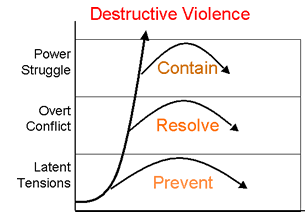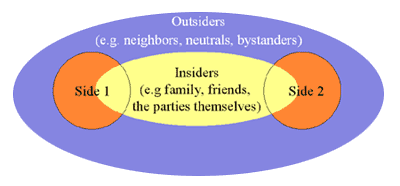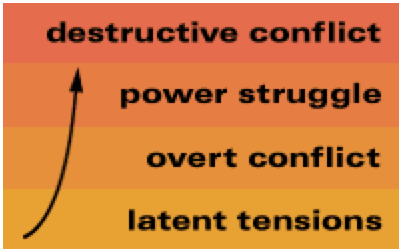Frequently Asked Questions
How can I be a thirdsider when I have a preference for a side?
A thirdsider can prefer one side of a conflict. The essence of being a thirdsider is not “objectivity”, but the knowledge that there is room for many perspectives in a conflict, and that the goal is a resolution satisfying to all.
Your task is to be true to your preference as well as to the interests of the whole.
Nelson Mandela is a perfect example of a man who had a strong preference for one side, yet maintained a thirdside perspective. A thirdsider does not have to be neutral or unemotional. You can have a very passionate voice as a thirdsider as you share your experiences, knowledge, and desire for a solution that will work for everyone.
How can I strengthen my ability to hold a thirdside perspective?
Holding the thirdside perspective requires practice; you need to be willing to try it again and again and again. There are conflicts and situations around us everyday that provide a field of practice for each of us. Choose any of these and attempt to take a thirdside perspective.
First, remember to go to the balcony. Distance yourself emotionally and physically far enough from the situation so that you can see it in its entirety. From here you can learn to manage your emotions; know when your emotions are triggered; and allow yourself to have these emotions and not be them. Being self-aware is an excellent first step. Over time you will find yourself being triggered less often.
Begin to notice any hidden assumptions that might be blinding you to a vision of the whole. Be open to the possibility that others – even those with whom you profoundly disagree – may hold a piece of the answer that must be included in order to make progress.
Let go of blame and find both/and rather than either/or ways to see. As you look at a conflict, always seek a solution that meets the interests of all parties, including the surrounding community. From this perspective you can generate creative options.
What are the skills I need to be a thirdsider?
Seeing, listening, and speaking from a thirdside perspective are skills critical to performing each thirdsider role. Please visit the Third Side Skills to learn more. Practice is essential to mastering each of these skills. They will become second nature as you use them.
What are the assumptions behind the Third Side?
Our understanding of the Third Side is based on a set of assumptions that are, like any assumptions, open to inquiry. Don’t accept these assumptions without first seeing if they are right for you. Find out for yourself and from your own experience how these assumptions work in your life and in your community. You can find some Third Side assumptions here.
What if I’m fearful of taking the Third Side?
There are both personal and societal reasons for not coming forward. Going to the balcony and understanding your fear is the first step. Here are some of the more dominant reasons people do not take the Third Side.
Personal reasons include:
- fear of retaliation or punishment,
- fear of losing a relationship,
- fear of losing face or being embarrassed,
- lack of moral courage,
- lack of skills about how to get involved,
- feeling like it won’t make a difference or it’s too much effort, or
- general fear of conflict and denial about the problem and whether it really exists.
Some societal reasons include
- feeling someone else will handle it,
- Genovese syndrome: thinking that it is someone else’s problem,
- not wanting to be a busy body, and
- overall societal fear of conflict.
If you are having these feelings, determine if there is any real threat to yourself and use your best judgment. It’s often helpful to remember situations from our past in which we have successfully entered a conflict as a thirdsider and helped bring about positive results for everyone. If a conflict feels too dangerous for you to comfortably enter consider how you can support the conflict as a witness and bring people’s attention to the situation; this is an important thirdside role.
Why should I care?
Destructive conflict tears our families apart, causes our companies to founder, ruptures our communities, and destroys our nations. Every year in the United States alone, twenty thousand people are murdered; almost a million girls and women are assaulted or raped by a current or former partner; more than fifteen million lawsuits are filed and more than a hundred and fifty billion dollars spent on legal costs. On the world stage, the wars in the former Yugoslavia, with their tens of thousands of casualties and millions of refugees, are also, tragically, not unique. At the turn of the millennium, more than two dozen full-scale wars are raging in the world, as are dozens of other violent intergroup conflicts. Even in the absence of war, there is terrorism. Everyone, everywhere, is vulnerable.
If we could transform our conflicts into constructive dialogues, the payoff for each of us individually and altogether would be enormous. Our families would be happier, our workplaces more productive, our neighborhoods more congenial, and our world a good deal safer. Click here to evaluate the cost of conflict in a situation you are familiar with.
How do I build a Third Side community and spread the Third Side idea?
Most importantly, you don’t need to start from scratch. Instead, begin with what you already do and add an extra thirdside dimension. Parents can help their children learn how to deal with conflicts constructively. A teacher can weave a conflict resolution strand into the subject matter, whether it is history, social studies, or languages. A minister can help people apologize and forgive. A lawyer can facilitate the creative resolution of conflicts by practicing “collaborative lawyering” or mediation. A journalist can spotlight emergent conflicts for public attention. A police officer can mediate domestic disputes informally.
Some of us may have special talents as Teachers, others as Mediators, and still others as Peacekeepers. The key is to identify your distinctive competence and incorporate it into what you do every day. As you find your place in the wider community, begin to look around and see if essential thirdside roles are being played. If you find a gap bring it to the attention of the community and support the ability to have these roles filled. Don’t fall into the trap of thinking you need to do it all yourself. Recruit help. This is how you begin to develop your thirdside web within your community.
Isn’t “war” human nature?
Destructive conflict, which disrupts our homes, work organizations, communities, and world, is widely accepted as an inevitable and prominent part of human existence. It’s hard not to believe after the most violent century on record with a hundred million victims of war and another hundred and seventy million victims of political violence and almost a million cases of domestic violence every year. But what if destructive conflict was preventable – and we did not know it? What if the biggest obstacle to prevention lay in our fatalistic beliefs? What if all those innocent children, women, and men dying from a stray bullet on our streets, from a terrorist bomb or an air raid – what if they were dying needlessly from a disease as preventable as smallpox?
The book The Third Side: Why We Fight and How We Can Stop contains a systematic inquiry into this question. It examines what we know about human nature, seeking to reconstruct a more accurate story of our human past and possible future. A few of the findings from the book are that:
- Ninety-nine percent of the human past consists of coexistence, not conflict.
Underlying our hopelessness is the story we commonly tell ourselves and our children about our past. People have been warring with each other since the beginning of time. Scratch the veneer of civilization and you will get a Kosovo or Rwanda.
For the last ten thousand years – during the last one percent of human evolution – there exists clear and often abundant evidence of organized violence and warfare. It takes the form of bones with spearheads or arrowheads embedded in them, mass graves, remains of fortifications, settlements destroyed violently, and ancient art depicting scenes of war and carnage. Much of the evidence of violence antedates “civilization” – defined as the building of cities, the invention of writing, and the birth of the state. There can be little doubt that violence and war leave clear traces in the archaeological record.
What is surprising, therefore is that convincing evidence of organized violence becomes so sparse before ten thousand years ago. In the period from ten to fourteen thousand years ago, there are two credible if controversial sets of evidence of small group violence, a cemetery in Jebel Sahaba, Sudan, and rock paintings in Arnhem Land, Australia; both instances seem to have occurred in the wake of catastrophic ecological change. Beyond that, there is evidence, in at least nine skeletons, pointing to scattered individual killings stretching back across time, but little or no evidence of war itself.
This doesn’t mean that our ancestors never killed one another. They almost certainly did. But they appear to have coexisted much more than they fought. And we’re not talking about an insignificant period of time, but 99% of our time on earth.
- We see polarities where we could see continuities of human concern.
The debate has long raged in and out of anthropology: Humans are naturally aggressive; no, aggression is learned. War is genetically based; no it is not. The answer is not one or the other but both. The polarities turn out to be false polarities. In these questions, there are no absolutes; everything is a matter of degree. In seeing only absolutes, one misses the critical degrees, yet it is in these degrees that lie the answers to the questions of how humanity has gotten along in the past and how we can get along in the future.
The debate, often fierce and emotional, unfortunately obscures where, in fact, scientists and scholars do agree. Few would disagree that humans are both capable of violence and capable of controlling violence. Most would acknowledge that humans sometimes live in a sustained condition of war but also sometimes live in a sustained condition of relative peace.
If human beings were as inevitably aggressive as we are often pictured, why do we not kill each other far more than we actually do? All the police in the world could not keep people from doing what comes naturally. If war is our natural state, why do the great majority of human conflicts not end in violence? How is it that human societies can live in internal peace and coexist nonviolently with their neighbors for long periods of time?
Just because we naturally eat doesn’t mean we need to overeat. Just because we like sex doesn’t mean we need to rape. Just because some humans like to dominate doesn’t mean we need to enslave others. That aggression is innate doesn’t mean that violence and war are inevitable. Indeed, there is nothing wrong with aggression in itself; primate mothers, for instance, use mild forms of aggression to teach their offspring correct behavior. It all depends on how the aggression is expressed and for what purpose.
- People are just as capable of constructing peace as they are of waging war.
Human behavior is extraordinarily flexible, as is reflected in the extreme variation in societal rates of violence. Some indigenous cultures like the Waorani of Ecuador manifest levels of violence as much as a thousand times higher than others, such as the Semai of Malaysia. Or consider the contrast between England and Colombia, more than fifty times more violent. Some of us live in societies that more closely resemble England in levels of violence, others in societies that more closely resemble Colombia, and most of us live somewhere in between. The level of variation alone suggests that far more than human nature is at play. One does not find whole societies that eat or make love even ten times more often than others, let alone a thousand times.
The variation derives, in great measure, from how people choose to deal with their differences. Violence is not an autonomous phenomenon but one choice among many for handling disputes. People are constantly coping with conflicts, their own and those of others, making choices as to which procedures to use. Humans, in other words, are conflict managers.Our common assumptions about human nature are mistaken. We are not by nature killer apes – one end of the continuum. This does not mean that we are naturally peaceful or harmonious either – the other end of the continuum. Rather, we are capable of both destructive and constructive responses to our differences. The answer to the assertion that “War is human nature!” is, “Yes and so is peace.”
- Human beings have an enormous potential for change.
Given our daily news diet of wars, street violence, strikes, lawsuits, and political battles, the conventional picture of human beings as naturally prone to violence is understandable. It misses, however, one fundamental point: Most of the time, most people get along. Although we may not give it much thought, we know this from personal experience. Despite differing temperaments, habits, and communication styles, most husbands, wives, and children manage to live together. Although they may disagree on basic values, most neighbors succeed in living side by side. Despite opposed interests, labor and management work together most of the time. Even with all their disputes, most nations are at peace with one another. The great majority of relationships among individuals, groups, and nation states are characterized far more by coexistence than by ongoing destructive conflict. Even in this most deadly of centuries, most people around the planet have lived most of their lives in a condition of peace, not war. Peace is the norm.
It is time, then, to stop thinking of peaceful coexistence as merely a vision. It is a reality. This is not to belittle the existence or importance of strife and war; far from it. It is just to remind us of the prosaic preponderance of peace.
Seeing human life as peaceful conflict resolution interrupted by periods of strife, rather than the other way, around transforms the challenge from the negative one of ending war to the positive one of extending the peace. Our task is not to change one absolute – war – into another absolute – peace. It is not to go from zero percent peaceful interaction to a hundred percent, but rather to go from something like ninety percent to something like ninety-nine percent.
An interesting analysis of this subject entitled “Is War Our Biological Destiny?” appeared in the New York Times, please click here.




